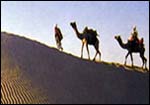

|
|
|
|
| HOME | TRAVEL | TRAVELOG | |||
 Through the Sands of Time ... Jaisalmer
Anvar Alikhan
Within the fort is the Maharawal's palace-- or rather a maze of interconnecting palaces, built over a period of 300 years. The Rang Mahal palace is the most interesting of them all, with its richly frescoed walls, depicting scenes of Rajput princely life. It is also notable for an incredibly intricate lattice screen that you automatically assume is carved out of wood, until you discover to your astonishment that it is actually carved out of solid stone! Jaisalmer is famed for its amazing stone carving. The silavats, or stone-carvers of Jaisalmer were so skilled that they could carve sandstone teacups so fine and light that they could actually float on water. The celebrated film director, Satyajit Ray, who was once shown one of these floating tea cups by the Maharawal on a visit to the palace, wrote "It was like magic, and we all but applauded."
Even more beautifully carved is Nathmalji ki Haveli, built by a prime minister of Jaisalmer as late as 1885. Its facade is a veritable riot of ornamentation -- flowers, birds, elephants, soldiers, as well, for some strange reason, a bicycle and a steam engine! A third haveli is known for its sinister history as much as for its carvings -- Salim Singh ki Haveli. It was built by a tyrannical, Borgia-like prime minister of Jaisalmer, a man who was so evil and hated that citizens of Jaisalmer finally got together and tried to stab him to death. And when his stab wounds unexpectedly began to heal, his own wife poisoned him, to make sure he met the end he deserved. The bazaars of Jaisalmer are a great place to browse, and as you wander through its narrow alleyways, you are transported back to the time when the products of India and China were exchanged here for the products of Arabia, Persia, Africa and Europe... when chintz, dried fruit, opium, silks, weapons and salt were exchanged for elephant tusks, dates, sandalwood, spaces and coffee. Today you can shop here for everything from colorful mirror-worked embroidery, tie-and-dyed fabrics, soft camel skin mojris, desert rugs and wood-carvings. Jaisalmer is also a great place to shop for chunky silver jewellery -- Different items of jewellery designed to be worn on almost every conceivable part of the human anatomy -- including an ornament called a chupara, designed to be worn on the teeth. You can also shop here - entirely legally -- for excellent bhang or marijuana -- which is in fact distributed by a government body quixotically named "The Department of Narcotics"! Jaisalmer is famed, too, for its ancient Jain temples, one of which -- the Sambhavnath temple -- houses a fabulous library of manuscripts, including the oldest surviving manuscript in India, believed to have been written by the great 11th century sage, Dronacharya himself. Twenty-six miles west of Jaisalmer lie the famed sand dunes of Samm. They have an awesome primeval beauty about them, their silken smooth sands sculpted into huge rippled hummocks by the scorching winds. The best way to get htere, of course, is on camel-back, an adventurous, Lawrence-of-Arabia-esque journey, that takes two days --and two spectacular nights, camping under the desert starscape.
The real beauty of Jaisalmer lies in the fact that it is so remote, so inaccessible -- and therefore unspoiled, even in today's age of mass tourism. As the old Marwari folk rhyme said about the remoteness of the town:
A horse of wood,
The time to go there is now. Before Jaisalmer gets an airport, God forbid, and before the planeloads of tourists begin to arrive.
|
|
|
Tell us what you think of this feature
|
|
|
HOME |
NEWS |
BUSINESS |
CRICKET |
MOVIES |
CHAT
INFOTECH | TRAVEL | LIFE/STYLE | FREEDOM | FEEDBACK |
|